Key takeaways:
-
Gemini is now used by crypto traders to monitor market catalysts and breaking news in real time.
-
The Gemini Pro version’s longer context window and web access boost its usefulness for macro and sentiment tracking.
-
It lacks native support for charts, portfolios or backtesting; traders still need external tools.
-
Gemini is a powerful signal tool, but you should always validate with real-time data before acting; AI can hint, but it can’t replace execution judgment.
In 2025, AI tools aren’t just summarizing text; they’re being used by crypto traders to make sense of fast-moving narratives. Gemini, particularly its Pro version, stands out because it can natively access Google Search. This means traders can ask it to pull news updates, summarize catalysts or cross-check signals without relying on plugins or extensions.
While ChatGPT remains dominant for trade structuring and prompt design, Gemini’s edge lies in its built-in Google Search capability. It can surface real-time news and cross-check catalysts without needing plugins. However, it has major limitations: no price charts, no exchange access and no execution capability. It won’t replace trading platforms, but it helps filter signals from noise.
Also, please note that Gemini does not forecast crypto prices. It helps verify whether a narrative or signal holds water. In noisy markets, that’s valuable but only when paired with other tools and human oversight.
Using Gemini for crypto trading: Strengths and limits, explained
Below are prompt templates for crypto trading, organized by workflow stage. Render Token (RNDR) is used as the example token, based on July 2025 data.
Please note that prompts used in steps 1 and 2 were fed to Gemini on July 10, 2025, to scan RNDR news
Market scan on RNDR token
“Scan Google News and major crypto publications for the last 24 hours on $RNDR. List top catalysts with links.”
Gemini’s output is shown in the image below.
Here are the four key signals Gemini is highlighting from the above output:
-
Narrative momentum: RNDR is consistently grouped with trending AI and Web3 tokens, reinforcing its long-term relevance.
-
Sentiment spillover: Positive coverage of similar tokens (e.g., BlockDAG, ICP, TAO) benefits RNDR by association.
-
Media visibility: Articles from July and May still carry weight due to narrative alignment, not just recency.
-
Sector leader tag: RNDR is directly named as a top AI crypto project in major 2025 outlook lists.
Narrative depth without real-time signal
Prompt used on July 10, 2025:
“Yesterday’s volume on RNDR spiked 50%. Summarize if any specific token announcements or wallet movements explain this, citing date/time and source.”
Gemini’s output:
Gemini’s output showed no clear news catalyst for RNDR’s 50% volume spike on July 9, 2025, instead offering contextual analysis tied to long-term AI narratives.
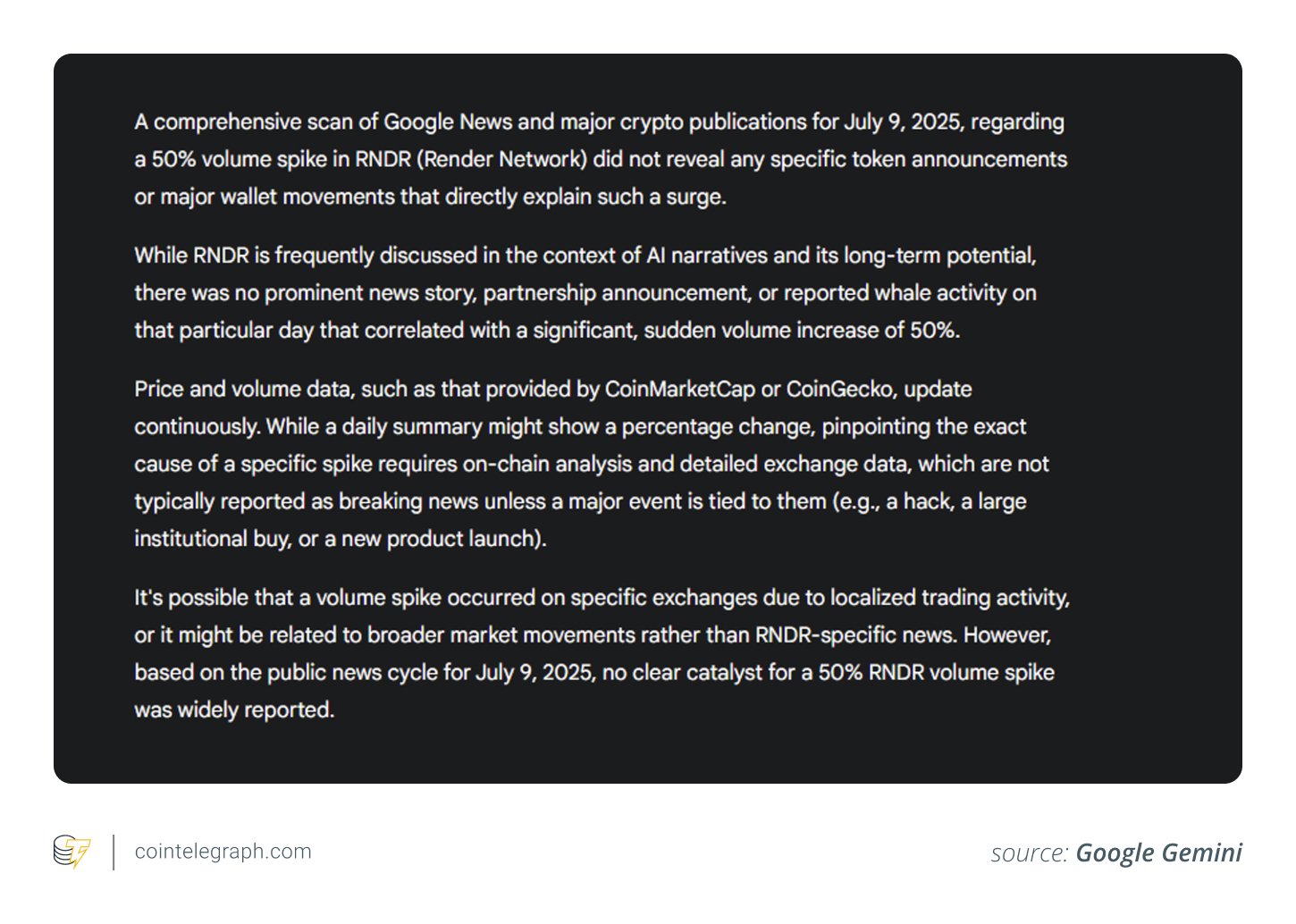
Gemini confirms broader narratives but often misses short-term catalysts, highlighting the need to cross-check with wallet trackers or token-specific feeds before trading volume spikes.
RNDR technical setup: Gemini can’t replace charts
Once the RNDR narrative checked out, Gemini was prompted to simulate a technical trade. It outlined assumed entry and exit levels using standard rules like the 200-day moving average (MA) but couldn’t verify live relative strength index (RSI) or moving average convergence/divergence (MACD).
Prompt used:
“I want a trade setup for RNDR based on technicals. Use 200-day MA for trend filtering; indicate RSI, MACD level, entry range, stop-loss, and target levels with risk/reward.”
As observed, while Gemini can generate a logically sound trade setup, like the one shown for RNDR, with defined entry, stop-loss and target levels, it does so based on assumed, not verified, technical indicators. Metrics such as RSI and MACD are approximated or manually inserted, not pulled from real-time price feeds.
As a result, any risk-reward ratios or suggested trade ranges are hypothetical and illustrative, not actionable without further verification. Gemini can assist with planning, prompt structuring and scenario modeling, but it cannot confirm trend conditions, monitor live volatility or adapt to sudden market shifts. This makes it useful for backtesting or learning but unsuitable for executing or timing real trades unless paired with a reliable charting tool or live market data platform.
Risk logic, not blind entry
Rather than chasing setups blindly, Gemini was asked to calculate position sizing and invalidation rules for a $10,000 portfolio risking 2% on the RNDR trade. It returned a max size of $3,240, assuming a 6.2% stop-loss, and flagged eight invalidation conditions, including bearish RSI shifts, negative news and macro disruptions.
Prompt used:
“Given the RNDR setup, what’s the max position size if I risk 2% of a $10,000 portfolio, and what scenarios might invalidate the trade?”
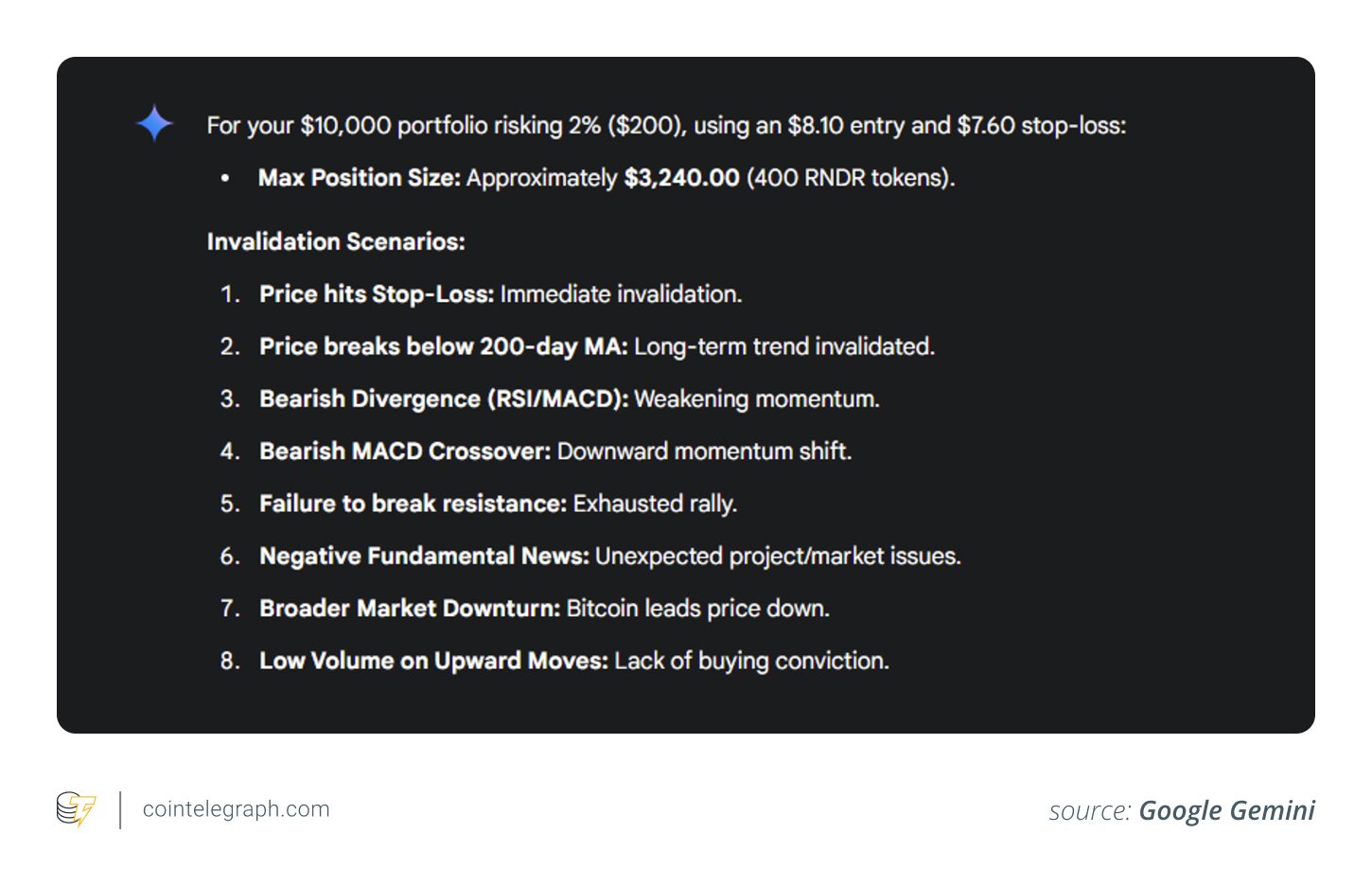
Gemini’s answer followed basic trading heuristics, but the final decision still depended on user-defined volatility and conviction. So, Gemini’s risk framing is useful but not precise.
When Gemini gets it wrong
Even advanced models have blind spots. Here are five ways Gemini can misfire in crypto trading:
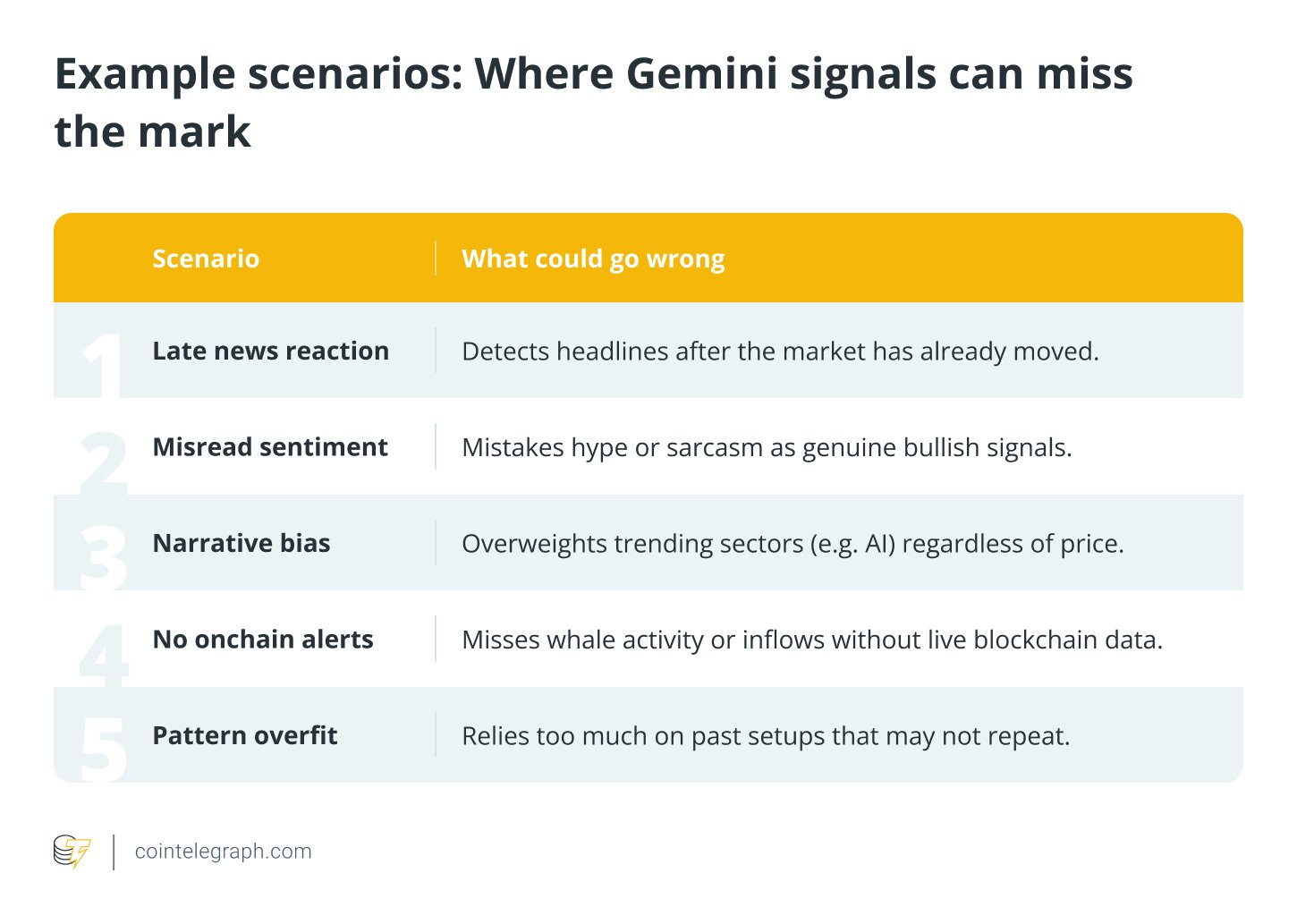
So, AI tools like Gemini can guide, but they’re not flawless. Always know the blind spots before you trade.
How Gemini compares with ChatGPT and Grok for crypto trading
Google Gemini isn’t the only AI tool traders are using, but it fits into a growing toolkit that includes models like ChatGPT and xAI’s Grok. Each has strengths and gaps, depending on what you’re optimizing for: market context, signal detection, trade planning or execution.
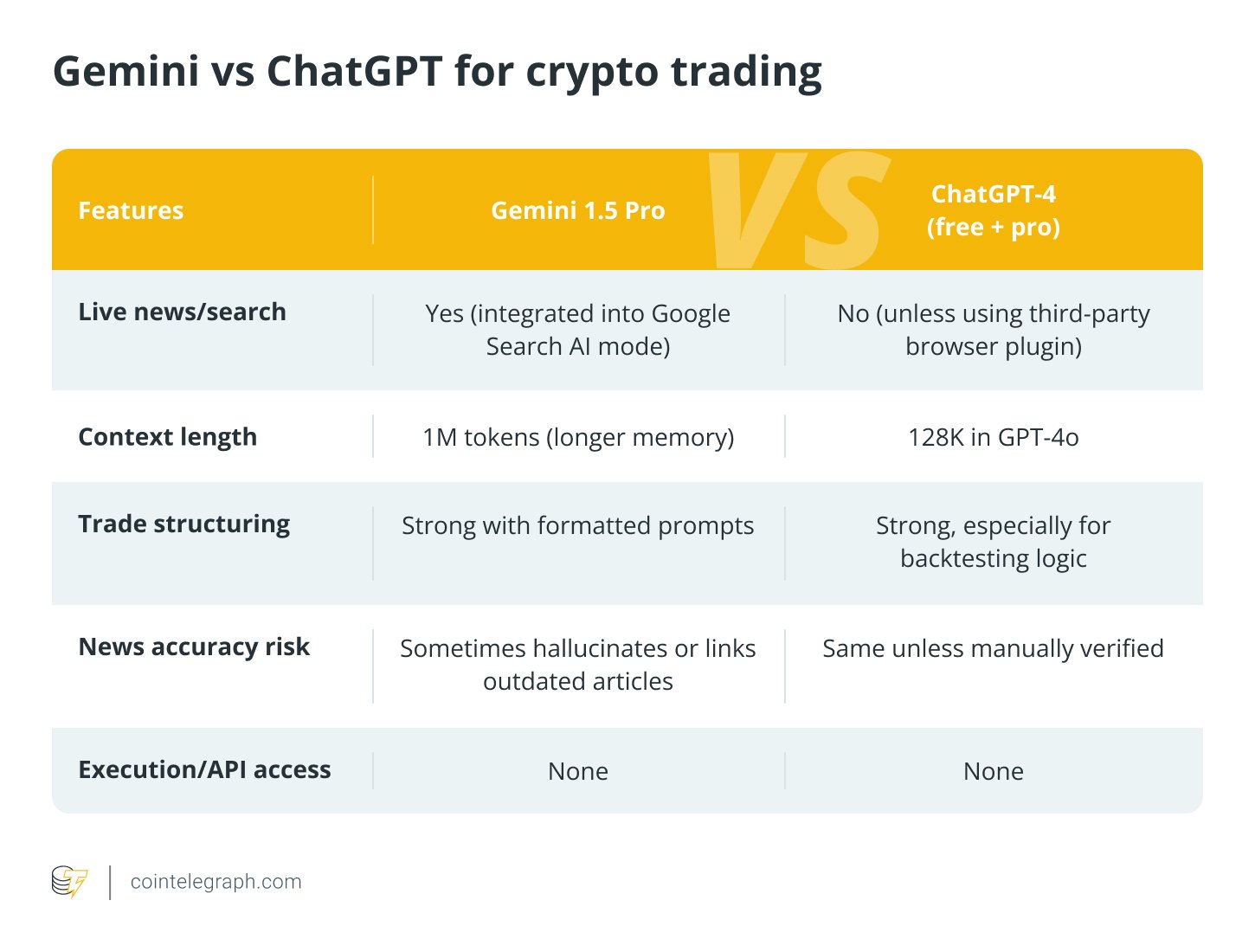
Gemini could outperform for news-driven setups, while ChatGPT may offer stronger support for coding strategies and trade simulations.
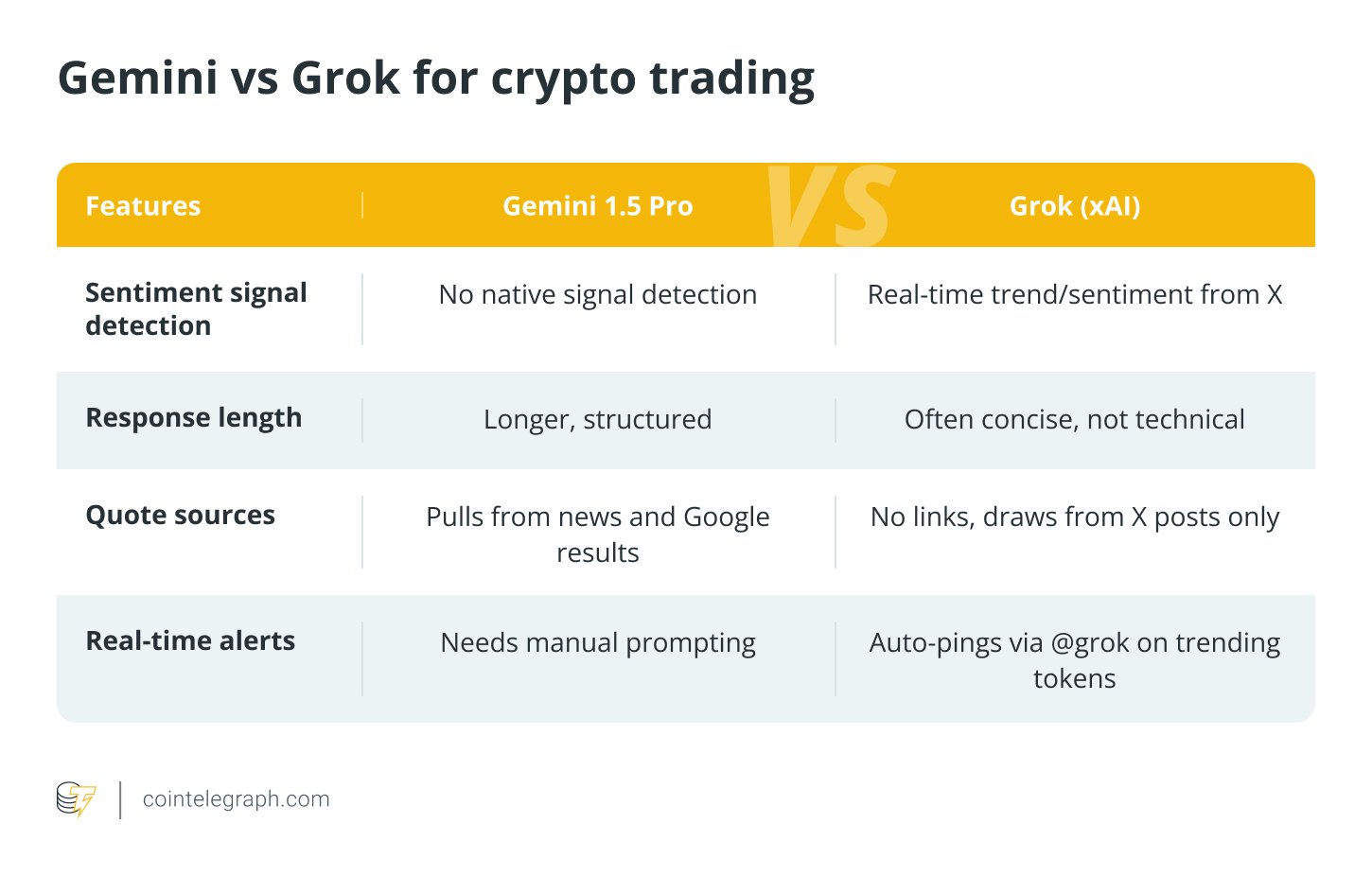
Depending upon their risk tolerance, traders could use Grok to detect token chatter, then Gemini to verify news validity and ChatGPT to structure a full trade plan.
How to use Gemini responsibly in crypto trading
Gemini can be used for research and structuring trade setups, not for live signals or execution. Always validate its outputs through platforms like CoinMarketCap or TradingView. For better results, combine it with tools like Grok (sentiment) and ChatGPT (logic). Since it lacks onchain and price feeds, all strategies should be tested in simulation before deployment.
Tips for using Gemini in crypto trading:
-
Use Gemini for narrative validation, not live trading.
-
Cross-check Gemini’s outputs with onchain data.
-
Combine Gemini with Grok (sentiment) and ChatGPT (logic).
-
Never trade without manually verifying RSI, volume or token flows.
-
Treat Gemini setups as drafts, not signals that test them in simulation first.
As AI becomes more integrated into crypto workflows, understanding how to prompt, how to verify AI-generated outputs and how to manage risk is more important than ever.
This article does not contain investment advice or recommendations. Every investment and trading move involves risk, and readers should conduct their own research when making a decision.














